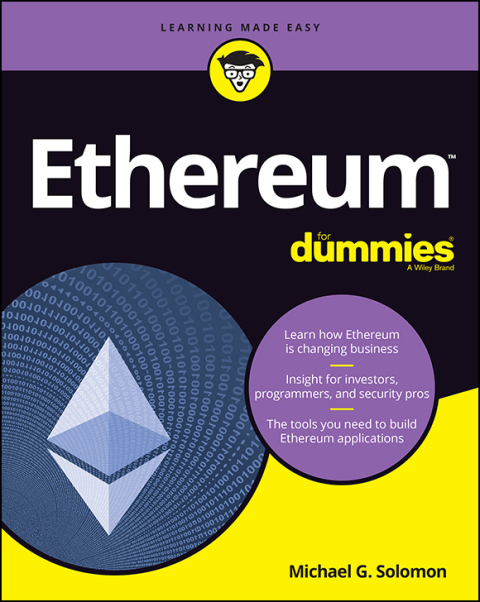Description
Efnisyfirlit
- Cover
- Introduction
- About This Book
- Foolish Assumptions
- Icons Used in This Book
- Beyond the Book
- Where to Go from Here
- Part 1: Getting to Know Blockchain and Ethereum
- Chapter 1: Introducing Ethereum
- Describing Blockchain Technology
- Introducing Ethereum
- Exploring Ethereum’s Consensus, Mining, and Smart Contracts
- Buying, Spending, and Trading Ether
- Getting Started with DAO and ICO
- Exploring the Ethereum Ecosystem
- Delving into Development Tools
- Building Blockchain Apps
- Chapter 2: Learning about Blockchain
- Exploring Distributed Applications
- Examining the Bitcoin Solution to the Distributed Dilemma
- Describing Blockchains
- Building Blockchains
- Understanding How Blockchains and Databases Store Data Differently
- Effectively Using Blockchains
- Chapter 3: Exploring Use Cases for Ethereum
- Diving Into Ethereum Applications
- Exploring Financial Services
- Establishing Digital Identity Management
- Examining Industry Applications
- Enabling Effective Governance
- Part 2: Setting Up Your Ethereum Development Environment
- Chapter 4: Examining the Ethereum Ecosystem and Development Lifecycle
- Exploring the Ethereum Blockchain Block Structure
- Describing Smart Contracts
- Introducing Solidity, the Language of Smart Contracts
- Working with the Ethereum Virtual Machine
- Fueling Your Code with Gas
- Surveying Tools for Developing, Testing, and Deploying Ethereum Apps
- Describing the Ethereum Development Lifecycle
- Introducing Smart Contract Development Tools
- Chapter 5: Getting and Configuring Ethereum Development Tools
- Examining Why Multiple Ethereum Development Tools Are Available
- Downloading, Installing, and Configuring All the Pieces
- Chapter 6: Establishing an Ethereum Wallet
- Unlocking the Secrets of an Ethereum Wallet
- Examining the Types of Ethereum Wallets
- Choosing an Ethereum Wallet
- Installing MetaMask, an Ethereum Wallet
- Part 3: Building Ethereum Distributed Blockchain Apps
- Chapter 7: Building Your First Ethereum Apps
- Validating Your Ethereum Development Environment
- Exploring the Ganache Test Environment
- Designing Simple Smart Contracts
- Coding Your First Smart Contract
- Running Your First Smart Contract
- Paying as You Go
- Chapter 8: Learning about Smart Contracts
- Introducing Supply Chain and Common Challenges
- Examining How Blockchain Can Help Resolve Supply Chain Problems
- Describing a Blockchain Supply Chain Solution
- Digging into Solidity
- Describing Basic Smart Contract Syntax
- Handling Data in Solidity
- Learning about Computation and Gas
- Exploring Access Modes and Visibility of Smart Contract Functions and Data
- Controlling Execution Flow
- Handling Errors and Exceptions
- Chapter 9: Writing Your Own Smart Contracts with Solidity
- Reviewing Supply Chain Design Specification
- Creating New Smart Contracts
- Coding Primary Functions
- Using Events
- Introducing Ownership
- Designing for Security
- Implementing Minimal Functionality
- Part 4: Testing and Deploying Ethereum Apps
- Chapter 10: Testing Ethereum Apps
- Understanding Ethereum dApp Testing
- Deploying a dApp to a Test Ethereum Blockchain
- Writing Tests for Ethereum dApps
- Logging and Handling Errors
- Fixing Bugs in a dApp
- Chapter 11: Deploying and Maintaining Ethereum Apps
- Test Blockchain Options versus Live Blockchains
- Anticipating Differences in Live Environments
- Preparing Your Configuration for Deploying to Different Networks
- Deploying a dApp
- Chapter 12: Integrating Non-Blockchain Apps with Ethereum
- Comparing Blockchain and Database Storage
- Contrasting Execution and Flow in Blockchain dApps and Traditional Applications
- Designing Goals for Incorporating Blockchain into an Existing Application
- Identifying Interface Data and Transaction Requirements
- Creating or Modifying Contracts to Provide Data Interface
- Testing Integrated dApps
- Deploying Integrated dApps
- Part 5: The Part of Tens
- Chapter 13: Ten Free Ethereum Resources
- Exploring Alternative Ethereum Development Frameworks
- Selecting a Free Integrated Development Environment
- Exploring Ethereum Clients and APIs
- Focusing on Wallets and Security
- Learning More About Developing Ethereum dApps
- Chapter 14: Ten Design Principles for Distributed Blockchain Apps
- Designing for Trust
- Enforcing Consistency
- Removing Doubt through Transparency
- Providing Feedback, Guidance, and Setting Expectations
- Handling Mistakes with Class
- Designing Functions that Focus on User Actions, Not Data
- Storing Data Based on User Actions, Not Data Structures
- Keeping It Simple
- Expecting Blockchain Access to Be Expensive
- Staying Out of the User’s Way
- Chapter 15: Top Ten Ethereum Projects
- Predicting Future Events with Gnosis
- Crowdsourcing Event Predictions in Augur
- Managing Decentralized Organizations with Aragon
- Breeding and Collecting Cryptokitties
- Exchanging Tokens with IDEX
- Creating Your Digital Identity with uPort
- Sharing Your Thoughts on the Blockchain with EtherTweet
- Searching for Jobs with EthLance
- Using TenX to Pay with Cryptocurrency
- Buying and Selling Computing Power with Golem
- Index
- About the Author
- Connect with Dummies
- End User License Agreement







Reviews
There are no reviews yet.